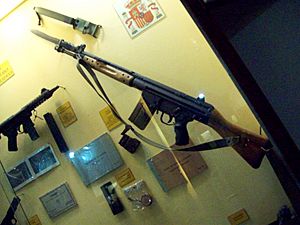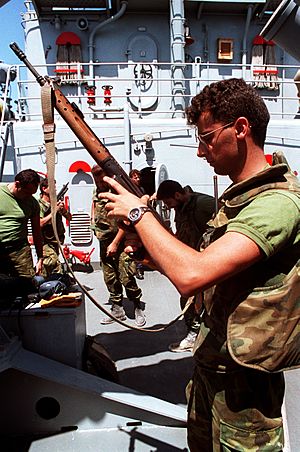CETME rifle facts for kids
Quick facts for kids CETME rifle |
|
|---|---|
| Type | Battle rifle |
| Place of origin | Spain |
| Service history | |
| In service | 1961–1992 |
| Used by | See Who used the CETME rifle? |
| Wars |
|
| Production history | |
| Designer | Ludwig Vorgrimler |
| Designed | 1948-1950 |
| Manufacturer | Centro de Estudios Técnicos de Materiales Especiales (CETME) |
| Produced | 1950 –1983 |
| Specifications | |
| Mass | 9.9 lb (4.49 kg) |
| Length | 40 in (1,016 mm) |
| Barrel length | 17.7 in (450 mm) |
|
|
|
| Cartridge | 7.62×51mm NATO |
| Action | Roller-delayed blowback |
| Rate of fire | Full-auto: 550-650 rounds per minute |
| Muzzle velocity | 2580 ft/sec |
| Feed system | 20-round detachable box magazine |
| Sights | Iron sights |
The CETME Model 58 is a type of battle rifle made in Spain. It was designed by the Spanish company Centro de Estudios Técnicos de Materiales Especiales (CETME). This rifle uses a 20-round magazine and fires 7.62×51mm NATO bullets.
The CETME 58 was very important because its design was later used to create the famous German Heckler & Koch G3 battle rifle. Some versions of the CETME rifle were also made for people to buy and use, not just for armies.
Contents
How was the CETME rifle developed?
The CETME rifle was mainly designed by a German engineer named Ludwig Vorgrimler. He based his ideas on earlier experimental German and French rifle designs. One key feature was its special "roller-delayed blowback" system. This system helps the rifle work smoothly when firing.
A clever idea in the CETME Model 58 was its "fluted chamber." This means the inside of the chamber has small grooves. These grooves help the empty bullet casing slide out easily after firing. This design leaves a unique mark on the spent casings.
What kind of bullets did the CETME use?
The original design for the CETME rifle had some big goals. Engineers wanted it to be light, weigh no more than 4.1 kilograms (about 9 pounds), and be able to hit targets up to 1000 meters away. It also needed a large magazine to hold many bullets.
To achieve this, a new type of bullet was created in 1953, called the 7.92x41mm CETME. This bullet was light and long, making it very aerodynamic. It weighed 6.8 grams and could fly at 800 meters per second (about 1,790 miles per hour).
Even though it was light, engineers found ways to make it stable in flight. This light bullet also meant the rifle had less "recoil" (the kick you feel when it fires). Less recoil made it easier to shoot accurately, especially when firing many shots quickly.
Later, a German border guard force became interested in the rifle. They asked for the bullet's diameter to be changed from 7.92mm to 7.62mm, while keeping the same 41mm case. This new bullet was called the 7.62x41mm CETME.
However, the German group later said they could only use the rifle if it fired the standard 7.62x51mm NATO bullet. This was because of agreements to use the same ammunition across different countries. So, the rifle was redesigned again to use this common NATO bullet. This version was called the Modelo B.
In 1956, the West German army tested 400 CETME A rifles. They gave feedback to improve the rifle's design and how comfortable it was to use. With help from the company Heckler & Koch, the rifle was made strong enough to fire the powerful 7.62 NATO round. The Model B then became the basis for the widely used Heckler & Koch G3 battle rifle.
The Spanish Army officially adopted the CETME B rifle in 1957. Production of the rifle began in Spain in 1961. Over time, four main models were made: A, B, C, and E. These models mostly differed in how they fired, if they had a bipod (a stand), and their weight.
Different models of the CETME rifle
Model A: The early prototypes
The Model A rifles were the first test versions. They had a unique way of firing: they would fire from a "closed bolt" in semi-automatic mode (one shot at a time) and from an "open bolt" in full-automatic mode (many shots quickly). Later models only fired from a closed bolt.
You can spot a Model A by looking at where the rear sight is and how its bipod folds back to form the front part of the rifle. In 1954, a small number of these rifles were used by the Spanish Army. They used the 7.92x41mm CETME bullet.
Model B: The first production version
The Model B was the first version made for regular use. It had a metal handguard with holes and fired the 7.62×51mm CETME bullet. This bullet was a bit lighter and had less powder than the standard 7.62mm NATO bullet.
Most parts of the Model B could be swapped with parts from the later Model C rifles. The Spanish Army later updated their Model B rifles to fire the more powerful 7.62×51mm NATO round. These updated rifles were known as Model 58-64-C. By 1971, all Spanish CETME B rifles had been upgraded.
Model C: The standard rifle
The Model C was a lighter version of the rifle. It was designed to fire the standard 7.62×51mm NATO round and had wooden parts for the stock. The Model C looked very similar to the Model B. However, some parts were made stronger to handle the more powerful NATO bullet. By 1974, the Model C had become the standard rifle for the Spanish Army.
Model E: The lightweight experiment
The CETME Model E tried to make the rifle even lighter by using plastic for the stock and aluminum for some metal parts. But after a short time, it was found that these rifles were not as strong as the older models. They would get damaged quickly with continuous firing. Because of this, only a few Model E rifles were made, and their production stopped quickly.
Model R: For armored vehicles
The CETME R was a special version of the Model B. It didn't have a buttstock (the part that rests against your shoulder). This model was made to be used inside armored vehicles.
Other CETME rifle versions
CETME L and LC: Smaller and lighter
The CETME Model L was a smaller version of the CETME rifle system. It was designed to fire the 5.56×45mm NATO cartridge, which is a smaller and lighter bullet. The Spanish Army adopted this model in 1984. It was used until 1999 when it was replaced by the Heckler and Koch G36 rifle.
Civilian versions: For collectors and enthusiasts
In the 1960s, a company in Chicago, USA, imported semi-automatic versions of the CETME B and C rifles from Spain. These were for people to buy and own. They often had a special "MARS" mark on them. Collectors today value these original Spanish-made rifles.
Later, in the late 1990s, another company called Century Arms International started making civilian versions. These were put together using military parts and new parts made in the USA. They were known as the CETME Sporter.
Because of rules about importing military weapons, the main body of these civilian rifles had to be made in the USA. Early versions had wooden parts, while later ones sometimes had plastic parts like the Heckler & Koch rifles.
It's safe to use 7.62×51mm NATO ammunition in the CETME Sporter. However, some commercial .308 ammunition might not work as well. The CETME's design causes it to forcefully eject empty bullet casings far away. These casings often get bent and can't be reused.
Who used the CETME rifle?
Main users
 Biafra - Biafran armed forces
Biafra - Biafran armed forces Bolivia: About 1,500 Model C rifles were bought for army reserves in 2003. They are also used by a special police group.
Bolivia: About 1,500 Model C rifles were bought for army reserves in 2003. They are also used by a special police group. Chad
Chad Republic of the Congo
Republic of the Congo Democratic Republic of the Congo
Democratic Republic of the Congo Djibouti
Djibouti Dominican Republic
Dominican Republic France - Some French special forces used CETME-B rifles that they found during the Algerian War. They kept using them in small numbers until the 1990s.
France - Some French special forces used CETME-B rifles that they found during the Algerian War. They kept using them in small numbers until the 1990s. Equatorial Guinea
Equatorial Guinea Lebanon - Lebanese Armed Forces
Lebanon - Lebanese Armed Forces Sahrawi Arab Democratic Republic - Polisario Front
Sahrawi Arab Democratic Republic - Polisario Front Spain - Spanish Armed Forces
Spain - Spanish Armed Forces Zaire
Zaire
Countries that tested the rifle
 West Germany: They tested the CETME Model A.
West Germany: They tested the CETME Model A.
The Spanish CETME A was also tested in the USA in 1954. The CETME Model A was shown to France, Sweden, and Italy in 1955. From 1957, a Dutch company also showed the CETME/H&K Model B rifle to the Dutch army, marines, Finland, Ecuador, and the Dominican Republic. However, no rifles were produced or ordered by these countries.
See also
 In Spanish: Cetme para niños
In Spanish: Cetme para niños
- CETME
- Heckler & Koch G3
- Heckler & Koch G41
- Heckler & Koch HK33
- List of weapons of the Lebanese Civil War



